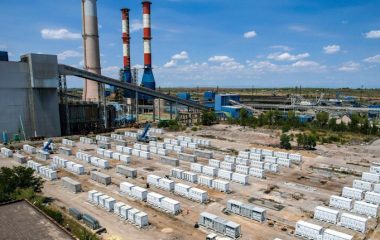
Photo: IPTO
Power interconnectivity in the region has just made another important step forward with the completion of the second cross-border transmission line between Greece and Bulgaria.
Greece’s Independent Power Transmission Operator (IPTO) announced today that a new international ultra-high voltage, 400 kV electrical interconnection began operation on Friday, June 30, following a trial run conducted through close cooperation between the two countries’ transmission system operators.
In the coming period, a permanent working group, staffed by all operators in the region, will determine the new, gradually increasing, available amounts of transmission capacity on the Greece-Bulgaria border and, from the end of the summer season, the new line is expected to start contributing to the cross-border trade.
The total length of the international interconnection, which starts from Nea Santa EHVC in Rodopi and ends at Maritsa East Substation in Bulgaria, is 151 kilometers, of which some 30 kilometers is within the Greek territory. Its capacity reaches 2 GW.
Skylakakis: More interconnections will follow
Greece’s new Minister of Environment and Energy, Theodoros Skylakakis, stated: “The second, international ultra-high voltage electrical interconnection of Greece-Bulgaria, is an important energy project of pan-European interest. The immediate benefits of this cooperation include: enhancing cross-border trade and strengthening energy security in Southeast Europe and the Balkan Peninsula. More international interconnections will follow, which will further upgrade our country on the European energy map.”
Renewables lead to more connectivity in the Balkans
Electricity trade between Greece and Bulgaria has been significant in recent years. Greece traditionally had large imports through the first transmission line because it needed cheaper Bulgarian power produced by coal and nuclear energy to bring down costs for its consumers.
Given the recent rise of renewable installed capacity in Greece, the country has also begun to export more energy abroad during the hours of the day when renewable production reaches a peak. This trend is expected to intensify in the future, especially since Greece has a goal of becoming an exporter of green energy in the wider region.
Manousakis: New interconnections with all neighboring states
This is why interconnections such as this one, and also the EuroAsia Interconnector, will become crucial as the European system decarbonizes further according to the 2030 goals.
Chairman and CEO of IPTO Manos Manousakis said that “over the coming years IPTO is launching new international interconnections with all neighboring states while at the same time supports major intercontinental interconnection projects in the Eastern Mediterranean, with Greece being the main hub.”
Recently, IPTO entered the EuroAsia project with a 25% share. This subsea electric connection will link Cyprus with Greece and Israel. The proposed 1,208-kilometer high voltage direct current (HVDC) cable would be the longest in the world. It is planned to be commissioned in 2028.
New power links with Cyprus, Israel, Turkey, North Macedonia
IPTO has included various projects in its ten-year development plan. Another regional project is the second 400 kV interconnection between Greece and Turkey, to be completed by 2029. The 130-kilometer line would have a capacity of 2 GW, running parallel to the existing one.
Italian operator Terna has agreed terms of reference with IPTO for a new interconnection, with four phases for its development. The goal is to increase capacity with a 1 GW high-voltage direct current cable under the Ionian Sea, from 500 MW currently to 1,500 MW.
Furthermore, IPTO and North Macedonia’s transmission operator MEPSO intend to upgrade their interconnection after 2030.
The Greek government is also working on the GAP and GREGY projects for subsea interconnections with Egypt, as well on upgrading existing links to Albania, Bulgaria and Italy.


















Be the first one to comment on this article.